|
What could make an otherwise sane person squeeze through tight passages, hundreds of feet below the Earth, encounter spiders, bats and icy cold mud with the very real possibility that they could be lost and die in the total darkness of the abyss?
Viewzone reader, Paul Jay Steward is such a man. And he is not alone. Throughout the world there are thousands of these human moles who regularly seek their thrills where no man has dared to tread. Although some people will call it an extreme sport, spelunking, as it is called, is no place for your typical adrenaline junkie-- in fact this sport requires enormous calm and self control and those who are prone to getting excited or anxious can easily find themselves dead.
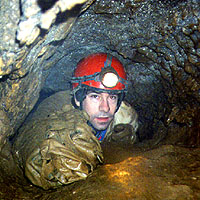 Paul (right) has been caving for many years. It's his passion. Like Neil Armstrong's walk on the Moon, Paul has been to places on this planet where no human-- perhaps no living thing-- has ever been. It's not often a person can boast of this feat. As Paul is quick to remind us, there's more to this sport than just the risk taking and ego building. Paul has seen beauty in caves and caverns, dimly illuminated by his helmet lights and sometimes photographed with his flash camera. Sometimes the caverns are small chapels of stone and water but there are also giant cathedrals with towering stalactites of brightly colored mineral deposits that echo his voice against the rhythm of dripping water which punctuates the absolute silence and solitude of these special places. Paul (right) has been caving for many years. It's his passion. Like Neil Armstrong's walk on the Moon, Paul has been to places on this planet where no human-- perhaps no living thing-- has ever been. It's not often a person can boast of this feat. As Paul is quick to remind us, there's more to this sport than just the risk taking and ego building. Paul has seen beauty in caves and caverns, dimly illuminated by his helmet lights and sometimes photographed with his flash camera. Sometimes the caverns are small chapels of stone and water but there are also giant cathedrals with towering stalactites of brightly colored mineral deposits that echo his voice against the rhythm of dripping water which punctuates the absolute silence and solitude of these special places.
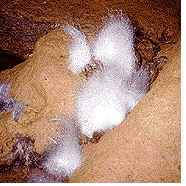 Paul has a good sense of humor-- something vital in this sport. The photograph on the left is of "raccoon turds," which Paul likes to photograph after the fungi and molds in this dark world have decorated them with what looks like "angel hair." His short stories and actual adventures reflect his deep thoughts and the reality of the dangers of caving. He contemplates the fatal consequences of even a minor physical injury or of getting lost with a companion and fantasizes about the necessity of eating human flesh to survive such an accident. Paul has a good sense of humor-- something vital in this sport. The photograph on the left is of "raccoon turds," which Paul likes to photograph after the fungi and molds in this dark world have decorated them with what looks like "angel hair." His short stories and actual adventures reflect his deep thoughts and the reality of the dangers of caving. He contemplates the fatal consequences of even a minor physical injury or of getting lost with a companion and fantasizes about the necessity of eating human flesh to survive such an accident.
His book of stories, Dirt, Danger And Darkness, is written with such a rare combination of dark humor and reality that one can almost smell the dank moist dirt of the caves he has wormed his tall, thin body through and we can get some ideas of the kinds of thoughts that must linger in his mind during these subterranean treks.
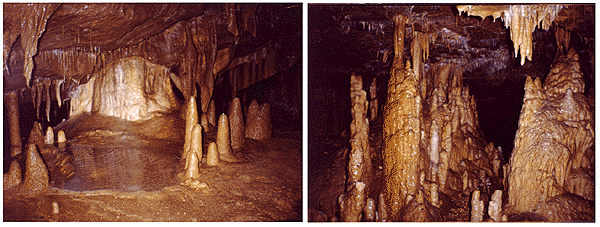
Many caves are formed by subterranean streams that have hollowed out and scoured the rocks for centuries. Minerals, dripping from the ceiling of these caverns, form spiked stalactites, while their deposition on the ground build up pires called stalagmites.
Paul offered us one of his "tamer" stories:
Deep inside the cave, I slowly worm my way into the tight,
vertical crack. I lie on my left side. My back and chest are wedged
between the passage walls, which are coated with a thick, sticky mud. Both of my arms are stretched out over my head, searching and grabbing for hand holds. The passage is too narrow to bend my legs. Inch by inch I move forward; push with the feet, pull with the arms. Between each move, I roll my pack and helmet a few more inches ahead. Two fellow cavers are only ten feet in front of me, but it feels like miles. It is reassuring to know they have made it through. Only known to them, I have yet to reach the “tight spot.” They call out words of encouragement to me, but I can't turn my head to see them. There is no room to turn around and backing up would be next to impossible. I don't think about reaching the end. I just think about moving; no matter how little or how slow, as long as I keep moving, I will reach the end.
Before squeezing past the tight spot, I rest. Muddy water from
a puddle soaks up into my clothes and cools my over-heated body. My warm breath forms a fog around my head. I calm myself by watching a cave cricket, cleaning its front legs. A bat flies by and its wings brush against my face. I am a unwanted visitor in his world. My body chills quickly and I move on.
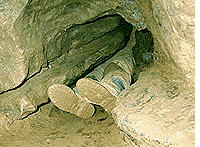 The tight spot is a large rock sticking out from the right
wall. As I inch by, I can feel a sharp edge scraping the skin from my
ribs. With each breath my chest expands, locking me between the walls. My heart is racing, breath out, move, rest, breath out, move. This is how I make my way through. Finally, I'm past the tight spot and my friends are close enough now to grab my arms and help pull me out. I turn and look back down the passage. One caver still has to make it through. He has heard our grunts and groans and knows it will be tough. He is the biggest in our group of four, it will be awhile before he too finally makes it through. The tight spot is a large rock sticking out from the right
wall. As I inch by, I can feel a sharp edge scraping the skin from my
ribs. With each breath my chest expands, locking me between the walls. My heart is racing, breath out, move, rest, breath out, move. This is how I make my way through. Finally, I'm past the tight spot and my friends are close enough now to grab my arms and help pull me out. I turn and look back down the passage. One caver still has to make it through. He has heard our grunts and groans and knows it will be tough. He is the biggest in our group of four, it will be awhile before he too finally makes it through.
According to the book there are no negotiable passages beyond
the crack, but as we stand, an inky blackness stretches as far as our
lights can see. There are no foot prints in the mud ahead of us and no
sign that humans have ever been here. This is every cavers dream--to be in virgin passage. As we continue, our lights expose stalactites hanging from the ceiling. We are the first people to ever gaze upon these sights.
While the rest of the group explores our new found world, I
sit down and rest. The voices of my friends fade into the distance. Water can be heard dripping from dark recesses of the cave. I feel more alone now, than I ever have. I think about having to go back through the squeeze. I feel like I'm on the moon, an explorer in an uncharted world. Because of us, one small cave has now become the states biggest. I wonder how long we've been in here. In a cave time is not measured in minutes or hours, but by how much light you have left. Your light is your lifeline, without light you cannot move.
The other cavers return and we talk about heading out. All of us
are cold and tired. It will be awhile before we're all safely out and our brown ceiling is replaced by a bright starry, warm August sky.
Caves are extremely fragile environments. Their features take hundreds of thousands of years to form. Cave life is rare and survives in a precarious ecological balance within the cave. Caves are also very dangerous and should only be explored by people who have been trained to do so. Please contact the National Speleological Society for more information on caves and where to find a caving club in your area.
For more information, you can contact:
The National Speleological Society
2813 Cave Ave.
Huntsville, Al. 35810
Going into caves is not for everyone. Those who are afraid of bats, bugs, tight places, the dark, getting dirty or the unknown should not venture in. We know how high the mountains are and how deep the oceans. Satellites have scanned every inch of the earth, but no one knows what lies just below the surface without going there. It is the last uncharted place on this earth. Who knows how many more caves and passages have yet to be discovered.
For those who want to explore caves, the first thing to do is get in
touch with the local grotto (caving club) in your area or the National
Speleological Society. By joining a grotto you can learn about the proper equipment and techniques used in caving. Other simple rules to follow are:
- 1. Most caves are on private property. You must have permission from the land owner to go into the cave.
- 2. Always tell someone what cave you are going in and when you plan to be out.
- 3. Never go in a cave alone. Always have at least four people in the group.
- 4. Always carry at least three different light sources that will give
you twenty four hours of light.
- 5. Be very careful around cave formations and cave life. Do not touch, take or break them. They take tens of thousands of years to form and are irreplaceable.
- 6. Do not disturb bats and stay out of the caves that have hibernating bats in the winter months.
- 7. If you do find a cave don't advertise the location to others.
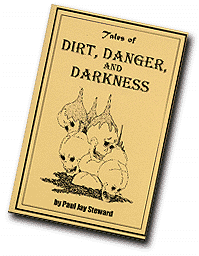 Paul Steward is a member and former chairman and vice chairman for the Central New Jersey Grotto, editor and writer for the Central Jersey Caver, a member of the New Jersey Cave Conservancy, a member of the Cave Research Foundation and a member of the National Speleological Society. Paul is also a columnist for the NSS News and the author of the book TALES OF DIRT, DANGER, AND DARKNESS by Paul Jay Steward. Paul Steward is a member and former chairman and vice chairman for the Central New Jersey Grotto, editor and writer for the Central Jersey Caver, a member of the New Jersey Cave Conservancy, a member of the Cave Research Foundation and a member of the National Speleological Society. Paul is also a columnist for the NSS News and the author of the book TALES OF DIRT, DANGER, AND DARKNESS by Paul Jay Steward.
Twenty six fiction stories from the twisted mind of Paul Steward takes the reader on a roller coaster ride of hell-filled passages.
Paul explores the dark side of caving: from alien encounters under
Roswell, to murder and fear in dark twisting caves. Guaranteed to give even the seasoned of cavers the chills. Paperback, 26 chapters, 120 pages.
Selling price $8.95 (Discounts available)
Shipping in the USA $2.50-for 1 copy.
Available through:
Greyhound Press
8677 S. State Road 243
Cloverdale, IN. 46120-9696
Or the author (signed copies available), Paul Steward
277 Clamer Road, Trenton, NJ. 08628. E-Mail to:pddb@juno.com
Viewzone || Strange Stories
|
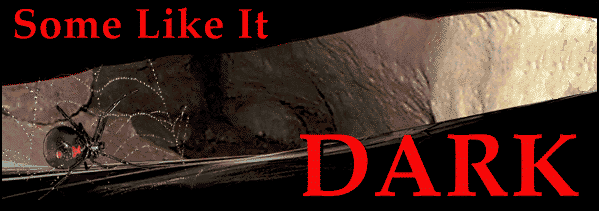


 Paul (right) has been caving for many years. It's his passion. Like Neil Armstrong's walk on the Moon, Paul has been to places on this planet where no human-- perhaps no living thing-- has ever been. It's not often a person can boast of this feat. As Paul is quick to remind us, there's more to this sport than just the risk taking and ego building. Paul has seen beauty in caves and caverns, dimly illuminated by his helmet lights and sometimes photographed with his flash camera. Sometimes the caverns are small chapels of stone and water but there are also giant cathedrals with towering stalactites of brightly colored mineral deposits that echo his voice against the rhythm of dripping water which punctuates the absolute silence and solitude of these special places.
Paul (right) has been caving for many years. It's his passion. Like Neil Armstrong's walk on the Moon, Paul has been to places on this planet where no human-- perhaps no living thing-- has ever been. It's not often a person can boast of this feat. As Paul is quick to remind us, there's more to this sport than just the risk taking and ego building. Paul has seen beauty in caves and caverns, dimly illuminated by his helmet lights and sometimes photographed with his flash camera. Sometimes the caverns are small chapels of stone and water but there are also giant cathedrals with towering stalactites of brightly colored mineral deposits that echo his voice against the rhythm of dripping water which punctuates the absolute silence and solitude of these special places. Paul has a good sense of humor-- something vital in this sport. The photograph on the left is of "raccoon turds," which Paul likes to photograph after the fungi and molds in this dark world have decorated them with what looks like "angel hair." His short stories and actual adventures reflect his deep thoughts and the reality of the dangers of caving. He contemplates the fatal consequences of even a minor physical injury or of getting lost with a companion and fantasizes about the necessity of eating human flesh to survive such an accident.
Paul has a good sense of humor-- something vital in this sport. The photograph on the left is of "raccoon turds," which Paul likes to photograph after the fungi and molds in this dark world have decorated them with what looks like "angel hair." His short stories and actual adventures reflect his deep thoughts and the reality of the dangers of caving. He contemplates the fatal consequences of even a minor physical injury or of getting lost with a companion and fantasizes about the necessity of eating human flesh to survive such an accident. The tight spot is a large rock sticking out from the right
wall. As I inch by, I can feel a sharp edge scraping the skin from my
ribs. With each breath my chest expands, locking me between the walls. My heart is racing, breath out, move, rest, breath out, move. This is how I make my way through. Finally, I'm past the tight spot and my friends are close enough now to grab my arms and help pull me out. I turn and look back down the passage. One caver still has to make it through. He has heard our grunts and groans and knows it will be tough. He is the biggest in our group of four, it will be awhile before he too finally makes it through.
The tight spot is a large rock sticking out from the right
wall. As I inch by, I can feel a sharp edge scraping the skin from my
ribs. With each breath my chest expands, locking me between the walls. My heart is racing, breath out, move, rest, breath out, move. This is how I make my way through. Finally, I'm past the tight spot and my friends are close enough now to grab my arms and help pull me out. I turn and look back down the passage. One caver still has to make it through. He has heard our grunts and groans and knows it will be tough. He is the biggest in our group of four, it will be awhile before he too finally makes it through. Paul Steward is a member and former chairman and vice chairman for the Central New Jersey Grotto, editor and writer for the Central Jersey Caver, a member of the New Jersey Cave Conservancy, a member of the Cave Research Foundation and a member of the National Speleological Society. Paul is also a columnist for the NSS News and the author of the book TALES OF DIRT, DANGER, AND DARKNESS by Paul Jay Steward.
Paul Steward is a member and former chairman and vice chairman for the Central New Jersey Grotto, editor and writer for the Central Jersey Caver, a member of the New Jersey Cave Conservancy, a member of the Cave Research Foundation and a member of the National Speleological Society. Paul is also a columnist for the NSS News and the author of the book TALES OF DIRT, DANGER, AND DARKNESS by Paul Jay Steward.